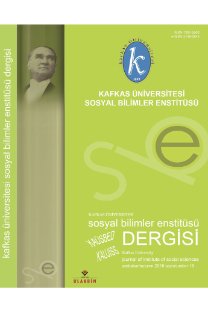DOUBLY OPPRESSED IMMIGRANTS IN BRICK LANE
Brick Lane Romanında Çifte Ezilmiş Göçmenler
___
Ali, M. (2003). Brick Lane. New York: Scribner.Allen, C. (2005). From race to religion: The new face of discrimination. In Muslim Britain: Communities under Pressure. Ed. Tahir Abbas. London & New York: Zed Books, 49-66.
Allen, C. (2010). Islamophobia. England and USA: Ashgate Publishing.
Bhillade, N. P. (2013). To speak about the unspeakable: Marginalized position of class, community and gender. The Criterion: An International Journal in English 4.6 (Dec.): 162-168. Retrieved 25 Dec. 2014 from http://www.the-criterion.com/V4/n6/Nilesh.pdf
Brah, A. (1996). Cartographies of diaspora: Contesting identities. New York and London: Taylor & Francis e-Library.
Cesari, J. (2007). Muslim identities in Europe: The snare of exceptionalism. In Islam in Europe. Ed. Aziz Al-Azmeh and Effie Fokas. Cambridge University Press: New York, 49-68.
Dutta, S. (2013). Remapping identity and selfhood: Multiculturalism and plurality in Monica Ali’s Brick Lane and Zadie Smith’s White Teeth. The Criterion: An International Journal in English 4.4 (August): 1-4. Retrieved 25 Dec. 2014 from http://www.the-criterion.com/V4/n4/Dutta.pdf
Fekete, L. (2009). A Suitable Enemy. London and New York: Pluto Press.
Kundnani, A. (2007). The end of tolerance: Racism in 21th century Britain. London: Pluto Press.
McLeod, J. (2004). Postcolonial London. UK, USA and Canada: Taylor & Francis e-Library.
Miles, R. and Brown, M. (2004). Racism. Second Ed. New York and London: Taylor & Francis e-Library.
Modood, T. (1993). Muslims, incitement to hatred and the law. In Liberalism, Multiculturalism And Toleration. Ed. John Horton. New York: Palgrave, 139-156.
Modood, T. (2005). Ethnicity and political mobilization in Britain. In Ethnicity, Social Mobility and Public Policy. Ed. Glenn C. Loury, Tariq Modood and Steven
M. Teles. New York: Cambridge University Press, 457-475.
Modood, T. (2009). Muslims and the politics of difference. In Muslims in Britain: Race, Place and Identities, Ed. Peter Hopkins and Richard Gale. Edinburgh: Edinburgh University Press, 193-210.
Parekh, B. (2000). Rethinking Multiculturalism. United Kingdom: Macmillan Press.
Pieterse, J. N. (2002). Europe and its others. In A Companion to Racial and Ethnic Studies, Ed. David Theo Goldberg and John Solomos. USA and UK: Blackwell Publishing, 17-25.
Weedon, C. (2004). Identity and culture: Narratives of difference and belonging. England: Open University Press
- ISSN: 1307-5500
- Yayın Aralığı: 2
- Başlangıç: 2008
- Yayıncı: Kafkas üniversitesi Sosyal Bilimler Entitüsü
KOBİ’LERİN NAKİT YÖNETİMİ TUTUMLARI ÜZERİNE BİR ARAŞTIRMA: KARS ÖRNEĞİ
Osman Berna İPEKTEN, Mehmet Emin KARABAYIR, Abdulkadir BARUT
NAHCİVAN DUZDAĞIN SAĞLIK TURİZM POTANSİYELİ
HOWARDS END: THROUGH THE LENSES OF BOURDIEUSIAN CAPITAL THEORY UNDER THE GUISE OF MODERNISM
İMÂM RABBÂNÎ’DE ALLAH TASAVVURU
OSMANLI TARİH YAZICILIĞINDA BİR İNTİHAL ÖRNEĞİ TELHÎSÜ’L-BEYÂN FÎ TAHLÎSÜ’L-BÜLDÂN
Rukiye ÖZDEMİR, Süleyman LOKMACI
MAGGIE TULLIVER AS A NEW WOMAN IN GEORGE ELIOT’S THE MILL ON THE FLOSS
